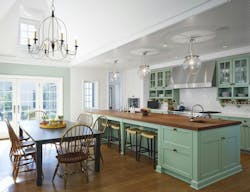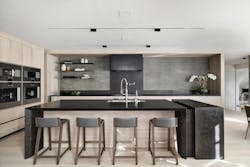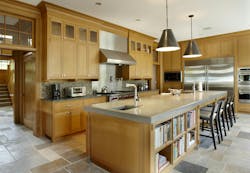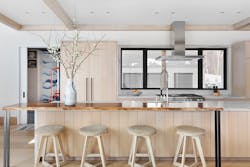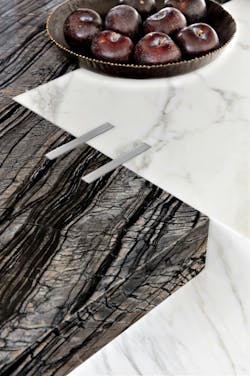As more family members gather in the kitchen to cook, do work, and hang out, the anchor of the room is increasingly a better outfitted island. Here’s what you should know to make it work and look its best.
Why the trend now?
What many homeowners tell their remodeling experts is that they want an island to help them multitask. “It’s a place to prep, cook, serve, and socialize,” says Zachary Helmers, an architect, and Managing Director at Workshop/APD. Especially as Covid-19 ramped up, the island become a place also to pay bills, do work, and art projects. In fact, Houzz, the online design site, found in its 2021 kitchen study that two-thirds of renovated kitchens feature an island. Before Covid-19, many used the larger countertop surfaces also for setting out a buffet. Many expect that trend will return once the virus is controlled, says designer Jodi Swartz, owner of KitchenVisions in Natick, Mass.
How big should it be?
One reason islands are getting larger is that they need to house more components to help perform so many tasks, says Swartz. But another is that due to the prevalence of the open-concept plan. some cabinetry, storage, counter space, and appliances had to be relocated as one—and sometimes--two walls came down to open the kitchen to an adjacent room. Some of Swartz’s bigger islands measure up to 60” by 110 ½” to include all features, she says.
Open concept floor plans means less space for shelving and cabinetry. This created a need for bigger islands to store kitchen items. ( Workshop/APD, Photo by Donna Dotan)
What typically gets incorporated?
Evanston, Ill.- based architects Stuart Cohen and Julie Hacker prefer using traditional stile and rail, inset panel cabinet doors for their kitchen designs unless the architecture calls for something very contemporary and then a flat panel door style would be more appropriate. Appliances consume most of the rest of an island’s square footage. Typical ones incorporated are refrigerator and warming drawers, a sink—these, too, are getting as big as 4’ to 5’ long and 19” wide, Hacker says, a dishwasher or two, and maybe a beverage center to spare opening and closing the refrigerator for cold drinks and fruit. Some of the bigger sinks also reflect the trend of thegalley workstation, which features a faucet, cutting board, strainer, and other tools and becomes a place for family and friends to prep collaboratively, says designer Chris Dreith, president of Home Improvements Group in Woodland, Calif.
While in years past, many installed a cooktop, Cohen and Hacker prefer not to because it might require a hood for venting, which can obstruct views of those standing or sitting around. Instead, for cooking, Swartz might install a microwave drawer below the countertop.
For comfortable seating, Cohen and Hacker prefer stools with backs for a standard 36” height countertop and if clients prefer chairs, they might lower one side to 30”. Generally, however, they don’t include two levels.
What about the aisles between island and perimeter walls?
As islands have gotten larger, it’s key to be sure the aisles all around are wide enough to maneuver easily. Cohen and Hacker prefer a 4’ or at least 42” width for walking comfortably and opening cabinet and range doors without bumping ones on the opposite side. “Going down to 3’ is too narrow,” Cohen says. To go bigger may add too many steps and an unnatural feel, Swartz says.
Experts say that at least 42” in width is needed around the island for walking comfortably and opening cabinet and range doors. (Stuart Cohen & Julie Hacker Architects, photo, Jon Miller)
Are granite countertops passé?
The countertop material matters for work, healthfulness, and aesthetics. As granite, especially speckled versions, became ubiquitous, new material favorites emerged, and most design pros have their favorites. Cohen and Hacker prefer porcelain, which resembles marble but doesn’t stain, etch, or scratch. It’s also heat resistant and antimicrobial. “We never liked synthetic materials before and preferred natural stone, but the new porcelains look so good and work so well,” Hacker says. They also like quartzite, a natural stone, more than manmade quartz. Dreith, however, prefers quartz to porcelain because of the consistency of its coloring and says less maintenance is needed than with quartzite. Whatever material is chosen, decide whether to conceal or play up seams if the island requires lengths larger than standard slab sizes.
This kitchen features a mixture of materials including marble and live-edge wood with white oak facing. ( Workshop/APD, photo, Shannon Dupre)
What about the color palette?
Despite the interest in bringing some color into kitchens, gray, white, and beige remain the most popular hues, according to Houzz. However, the island offers a place to introduce some contrast to what’s on perimeter boxes, says Swartz. Cohen says a mix is also a way to add visual relief in a large kitchen. In one project, he and Hacker went with midnight blue to match the homeowner’s La Cornue French range. The other cabinets around the perimeter were painted white. Swartz also has found that a kitchen can be a place to have fun with color and recently designed kelly green and turquoise kitchens. But she cautions not to use too many different choices. “If you break up cabinetry with different colors throughout the room, then use one material and color for the countertops,” she says.
This unusual seam detail adds interest to the design while tying together two different materials. ( Workshop/APD; Photo, Donna Dotan.)
Other ways to distinguish one island from another?
To give a kitchen a personalized look, a number of details can provide spark. Cohen and Hacker often use one overscaled light fixture above an island rather than the almost cliched trio of hanging pendants, and then add recessed cans for supplemental light. They prefer some understated but interesting hardware, perhaps, in crystal and a simple design. Other newer finishes are showing up, too, from bronze to copper, and black and sometimes more than one in a room. Helmers has added built-in troughs, some with a drain to place beverages and ice for a party, and others with a cover to conceal multiple outlets.
About the Author

Barbara Ballinger
Barbara Ballinger, is a writer who focuses on real estate, design, and personal subjects. Her latest book is Not Dead Yet: Rebooting your life after 50.
